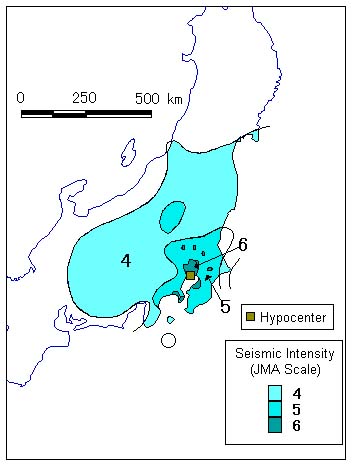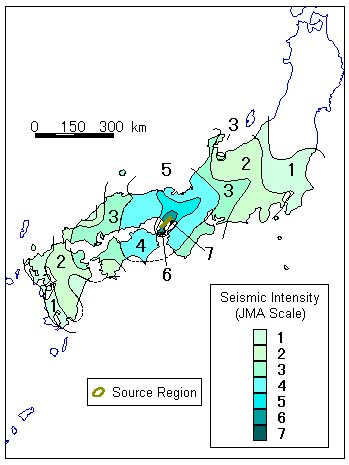Tuesday, 13 March 2012
Quakes around 1855 and 1894
Is this significant? Well, I have no idea, to be honest, but I thought that it was worthy of noting, especially as northeast Japan had a massive one on 11th March.
One of the quakes, 15th June 1896 Meiji-Sanriku earthquake, was in a similar region, along the Japan Trench, to that of the March 2011 quake.
It must also be mentioned that the Japan Trench has regularly produced some huge quakes which can occur in locations extending from offshore Aomori Prefecture to offshore Ibaraki Prefecture,
Three of the top six quakes ever recorded worldwide, including the 2011 Tōhoku quake, appear to be clustered in a 6.2-year span between 2004 and 2011; however, experts construe this as a statistical anomaly or random chance.
Anyway, here's the quakes:
December 23, 1854 Ansei-Tōkai earthquake 8.4M
December 24, 1854 Ansei-Nankai earthquake 8.4M
November 11, 1855 Ansei Edo earthquake
April 9 1858, Hietsu Earthquake 7.0-7.1M
April 7, 1889 Kumamoto earthquake 6.3M
October 28, 1891 Mino-Owari Earthquake 8.0M
June 20, 1894 Meiji Tokyo Earthquake
June 15, 1896 1896 Meiji-Sanriku earthquake 8.5M
Monday, 12 March 2012
Depth of 1855 Ansei Edo quake
Location and Magnitude of the 1855 Ansei Edo Earthquake
Japan Meteorological Agency intensity assignments from a set of recent calibration earthquakes were used to derive two intensity attenuation models suitable for estimating the location and magnitude M for historical earthquakes in Japan (Bakun, JGR, 2005). The "Honshu model" is appropriate for shallow crustal earthquakes. The "subducting-plate model" is appropriate for Pacific plate and Philippine Sea plate interplate and intraslab earthquakes. Intensities decrease more rapidly with distance from the source in the Honshu model than in the subducting-plate model, consistent with many studies showing that the colder, high-velocity, high-Q subducting Pacific and Philippine plates act as efficient waveguides for propagating strong shaking from earthquakes. M estimated from a set of intensity assignments is significantly larger for a Honshu-model source than for a subducting-plate model source. It is clear from the pattern of damage that the destructive 11 November 1855 Ansei Edo earthquake occurred near Tokyo, but the focal depth and causative seismogenic structure are controversial. M estimated using intensity assignments range from 7.2 and 7.4 for a subducting-plate-model source at 30 km and 70 km depth, respectively, to 7.7 for a shallow (5 km depth) Honshu-model source. The focal depth and causative seismogenic structure cannot be resolved from the pattern of intensity assignments. Historical accounts suggest that the 1855 Ansei Edo earthquake was preceded by alterations in groundwater and springs. In addition, 78 aftershocks were felt in Tokyo in the month immediately following the earthquake. These observations argue against a deep subducting-plate source. Surface faulting was not reported in 1855 and an order of magnitude more aftershocks were felt after the shallow crustal 1994 M7.3 Kobe earthquake -observations that suggest a somewhat deeper source for the 1855 Ansei Edo event. More felt aftershocks were reported in 1855 than after the 1987 off-Chiba M6.7 Philippine Sea plate intraslab earthquake (47 km focal depth). The 1855 aftershock activity and other historical accounts are apparently consistent with an M7.2 subducting-plate model source at about 30 km depth.http://adsabs.harvard.edu/abs/2005AGUFM.S21A0197B
-------------------------------------------------------------------------------------------------
Insights on the 1855 Ansei-Edo earthquake depth derived from attenuation tomography and comparison with the 23 July 2005 M=6 shock
The 3-D attenuation structure, Q, beneath the Kanto plain (Nakamura et al, 2003), Japan, has been obtained using short-period strong ground motion records from Kanto and Tohoku. Low Q is consistent with the Vp/Vs structure, and is associated with the active volcanic front (Nakajima et al, 2001). In addition, there is an unexpected low-Q zone oriented E-W beneath the Kanto plain. This low-Q band is coincident with high Poisson ratios, which have been interpreted as a serpentinized zone (Kamiya and Kobayashi, 2000). The heterogeneous attenuation structure must affect seismic ground motions for large events such as the damaging 1855 Ansei-Edo earthquake. First, we compare the distribution of seismic intensity between recent earthquakes and the Ansei-Edo shock. Despite the large and high quality intensity dataset for the 1855 shock, there are many difficulties in estimating its hypocenter. It is possible, for example, that different hypocenters produce the same seismic intensity distribution because of the complex attenuation structure. Considering these difficulties, we examine the ground motion of the Ansei-Edo and M=6 23 July 2005 earthquakes, and find out that the two intensity distributions are very similar. Second, we calculate the predicted ground motions using our 3-D Q structure for several trial 1855 hypocenters, principally in an attempt to infer whether the 1855 source was deep or shallow. Because of the observed high intensities characteristic of Kisarazu and the eastern Kanagawa prefecture shared by the Ansei-Edo and 23 July 2005 shocks, and the good match of these observations to the prediction using the 3-D Q structure, we infer a similar characteristic intensity distribution. We thus conclude that the 1855 Ansei-Edo earthquake may have occurred at the north end of Tokyo bay at a depth of about 70-80 km.
http://adsabs.harvard.edu/abs/2005AGUFM.S21A0198N
Kobe Quake video
A lot of talk about running out of the building as a quake happens, but judging from how much the buildings are moving, I'd say it would be very hard to navigate your way out of the door, especially if the door is blocked by one of the cupboards.
To add, it may be at night and the lights are out.
The Kobe quake was a duration of 20 seconds.
By the time the quake started and you've managed to pick yourself up off the floor, move several items that are blocking doors, forced the door open if the frame has been bent out of shape, and then got down several flights of stairs, safely, the quake would have been over.
And all of this whilst trying to remain upright.
You can see how strong the quake was from the initial jolt and seemed to calm down towards the end of the videos.
Must have seemed like a lifetime though.
In the second video you can see the motion that the quake sends the building in...almost circular.
Again, the running out of the building theory doesn't seem an option.
1995 Kobe Quake
The Southern Hyogo Prefecture Earthquake occurred on the Rokko-Awajishima fault zone that stretches from the Hanshin area of southern Hyogo Prefecture to Awajishima Island. During this earthquake, seismic intensity 6 in JMA scale was observed at the Kobe Marine Observatory and the Sumoto Weather Station. Field investigation have shown, however, that an area from part of the Awajishima Island to Kobe and Takarazuka corresponded to a seismic intensity of 7 in JMA scale. Seismic intensity 5 in JMA scale was observed in Kyoto, Hikone, and Toyooka, while ground motion corresponding to a seismic intensity of 5 in JMA scale was observed in Osaka, depending on the ground conditions (Fig.7-13, Fig.7-14). In addition to many wooden houses and concrete buildings, rail and highway lines collapsed, including those for expressways and the Shinkansen. The damage was extremely severe, totaling 6,427 dead and missing, more than 40,000 injured, more than 110,000 houses completely collapsed, and 285 fires (as of December 26, 1996) (Fig.7-15). The earthquake occurred in the early morning; thus, many of the deaths were the result of collapsing houses or fires. Harbor facilities were also damaged as a result of liquefaction, and the rains after the earthquake caused landslides as well as other damage. The damage caused by this earthquake is referred to as the Great Hanshin-Awaji Earthquake Disaster.
Slipping of the earth's surface at the Nojima fault (Nozima fault) on Awajishima Island resulted from this earthquake (Fig.7-16). The southeastern side of Nojima fault rose a maximum of 1.4 m to the northwest, and slipped a maximum of 2.1 m to the southwest. Observation of crustal deformations during this earthquake show that the area surrounding the focal region was compressed in an east-west direction and that the southeastern side of the Nojima fault rose to the northwest (Fig.7-17). It was also determined that the northwest side of the focal region rose to the southeast in the Hanshin area, in contrast to the uplift on Awajishima Island. These deformation suggest that the area was subjected to compression in an east-west direction. This is in rough conformity with the topography of the area and previously known crustal movements. No large-scale movement occurred in the Hanshin area, however. It is difficult to believe that the Rokko Mountain (Rokko Santi) area was formed by repeated earthquakes of the same type as the Southern Hyogo Prefecture Earthquake, so we must conclude a different type of earthquake was responsible for the formation of this area. For example, it has been suggested  that the 1596 Keicho Fushimi Earthquake (M 7 1/2) might be this type of event.
that the 1596 Keicho Fushimi Earthquake (M 7 1/2) might be this type of event.
Many felt and unfelt aftershocks occurred after the Southern Hyogo Prefecture Earthquake. This aftershock activity gradually diminished, with the largest aftershock (M 5.4) occurring about two hours after the main shock (Fig.7-18, Fig.7-19).
A Special Measures Law on Earthquake Disaster Prevention was promulgated after the occurrence of this earthquake, and the Headquarters for Earthquake Research Promotion was established.
1894 Meiji Tokyo quake
This earthquake occurred in a location deep under the eastern part of Tokyo, and is thought to have been within the subducted Pacific Plate. Strong ground motion was felt, particularly on the coast of Tokyo Bay. Ground motion corresponding to a seismic intensity of 5 in JMA scale was felt in eastern Tokyo, eastern Kanagawa Prefecture, southeastern Saitama Prefecture, and other locations. In some areas, there was ground motion corresponding to a seismic intensity of 6 in JMA scale (Fig.5-32). There was heavy damage along Tokyo Bay coast in Tokyo and Yokohama, as well as 31 fatalities in total (Fig.5-33). Cracks and liquefaction of the ground occurred throughout the affected areas.
The precision of observation equipment was still not advanced at this time. Therefore, of the earthquakes observed in this area within one year after the main shock, only the one (M 6.7) occurring three and a half months after the main shock is thought to be an aftershock.
Sunday, 11 March 2012
1855 Ansei Edo Quake quick notes.
Magnitude: 7.0
Epicentre: Tokyo Bay. Now a built-up area. Closest station is Toyosu.
http://mapper.acme.com/?ll=35.65,139.8&z=11&t=M&marker0=35.65,139.8,1855%20Ansei%20Edo%20earthquake
Casualties: 7,000
Damage: Approx 50,000 houses detroyed by quake and subsequent fires.
Sites of interest
http://www.jma.go.jp/jma/en/menu.html
Quake Prediction Sites:
http://quakeprediction.com (updated daily)
http://geoq.ru/eindex.htm
Headquarters for Earthquake Search Promotion:
http://www.jishin.go.jp/main/index-e.html
Global Disaster Watch:
http://globaldisasterwatch.blogspot.com/
Interesting blogspot that ran an interesting article here:
http://globaldisasterwatch.blogspot.com/2012/02/monday-february-20-2012.html
NASA Astropysics Database Systems:
http://adsabs.harvard.edu/cgi-bin/nph-basic_connect
Study and distribution of seismic intesity 1855 Ansei Edo quake:
http://library.jsce.or.jp/Image_DB/eq1994/proc/00037/380-0201.pdf
1855 Ansei Edo Quake
Regarding the 1855 Ansei Edo Earthquake (M 6.9), there are two ideas: first, it has been caused by active fault movement close to the surface; second, it has occurred on the upper surface of the Philippine Sea Plate.
The Ansei Edo Earthquake is thought to have occurred in a shallow or moderately deep area near the mouth of the Arakawa River (Ara Kawa). It generated strong ground motion over a wide area in the Kanto region, and its ground motion is estimated to have been the equivalent of seismic intensity 6 in JMA scale in eastern Tokyo, northwestern Chiba Prefecture, and eastern Saitama Prefecture (Fig.5-20 and Fig.5-21). This earthquake caused extensive fire damage over a wide area. Liquefaction of the ground is also known to have occurred in several locations. There were more than 7,000 fatalities in all. While there was no report of the tsunami generated by this earthquake, a large number of aftershocks are thought to haUve occurred (Fig.5-22). Historical data reveal that several phenomena occurred before the earthquake, including the spring of groundwater and ground rumbling.

